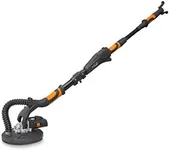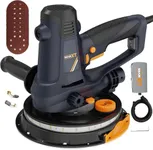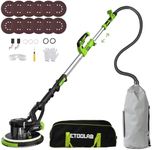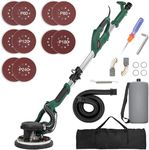Buying Guide for the Best Electric Drywall Sanders
Choosing the right electric drywall sander can make your drywall finishing projects much easier, faster, and less tiring. The right tool will help you achieve a smooth, even surface with less effort and mess. When shopping for an electric drywall sander, it's important to understand the key features and specifications that affect performance, comfort, and suitability for your specific needs. By focusing on these aspects, you can find a sander that matches the size of your projects, your experience level, and the type of work you plan to do.Motor Power (Wattage)Motor power, usually measured in watts, determines how strong and efficient the sander is at removing material. Higher wattage means the sander can handle tougher jobs and work for longer periods without overheating. For small, occasional projects, a lower wattage (around 500-600W) may be sufficient. For frequent use or larger areas, look for sanders with 700W or more. Consider your workload: if you plan to sand entire rooms or work on thick joint compound, a more powerful motor will save you time and effort.
Disc SizeThe disc size refers to the diameter of the sanding pad, typically measured in inches or millimeters. Common sizes are 7 to 9 inches. Larger discs cover more area quickly, making them ideal for big walls and ceilings, but they can be harder to control in tight spaces. Smaller discs are better for detail work and corners. Think about the size of the surfaces you'll be sanding: for mostly large, open areas, a bigger disc is helpful; for smaller rooms or lots of corners, a smaller disc may be easier to handle.
Variable Speed ControlVariable speed control lets you adjust how fast the sanding pad spins. This is important because different surfaces and stages of sanding require different speeds. Lower speeds are good for delicate finishing and reducing dust, while higher speeds remove material faster. Some sanders have fixed speeds, while others offer a range. If you want more control and versatility, look for a model with variable speed. This is especially useful if you work on a variety of projects or materials.
Dust Collection SystemDrywall sanding creates a lot of fine dust, which can be messy and unhealthy to breathe. Many electric drywall sanders come with built-in dust collection systems, such as vacuum attachments or dust bags. A good dust collection system keeps your workspace cleaner and protects your lungs. Some systems are more effective than others, so check how the dust is captured and whether you can connect the sander to a shop vacuum. If you work indoors or want to minimize cleanup, prioritize a strong dust collection feature.
Weight and ErgonomicsThe weight and design of the sander affect how comfortable it is to use, especially for long periods or overhead work. Lighter sanders are easier to maneuver and cause less fatigue, but may be less powerful. Ergonomic handles and adjustable lengths can also make a big difference in comfort. If you expect to sand ceilings or work for hours at a time, look for a lightweight, well-balanced sander with comfortable grips and adjustable features.
Reach and ExtensionSome sanders come with telescoping or extendable handles, allowing you to reach high walls and ceilings without a ladder. The maximum reach is important if you often work in rooms with high ceilings or want to avoid climbing. If most of your work is at standard wall height, a shorter, more compact sander may be easier to control. Consider the typical height of your projects and whether an extension feature will make your work safer and more efficient.















